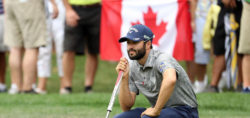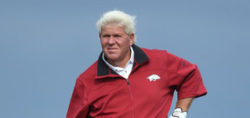DUCK! When Tour Players’ Shots Carom Off Gallery Body Parts

I constantly marvel at fearless (or oblivious) golf galleries who huddle around a Tour player to get a better look at the shot. The crowding would never occur if one of us weekend warriors were attempting to hit–unless folks were asking for a death wish.
Golfworld.com’s Brian Wacker describes how errant shots not only affect fans but also the players.
The PGA Tour slogan is true, these guys are good. But they’re also human. For all the years they’ve spent playing the game and practicing their million dollar swings, sometimes their golf ball disobeys. And when a shot wanders offline at a professional tournament, with spectators present (albeit not always paying attention), well, there’s a decent chance somebody will meet the working end of a Titleist.
We’ll let you in on another secret: This happens more than you might imagine. In a four-hole stretch during the Genesis Open at Riviera Country Club outside Los Angeles, Pat Perez managed to drill three spectators with errant shots. One of them had to leave on a stretcher.
“Everyone thinks we’re going to hit it straight all the time,” Perez said. “We don’t.”
“Of course, it’s unsettling,” Perez said. “He had to leave on a f—ing stretcher. You make sure the guy’s OK, but you’ve got to keep going unfortunately.
“I called him that night to see how he was doing. He was shocked. I said, ‘Bro, I almost killed you. It’s not that much for me to call you.’ He said, ‘I’m good.’ I said, ‘Sorry.’ I gave him a glove, but what is that gonna do? He was bleeding. It sucks. It’s hard to hit a shot after that, but it’s one of those things you just have to move on from.”
Unlike baseball and hockey, no one to date has been killed by an errant golf ball in a professional tournament, a surprise considering that ball speeds from PGA Tour players reach as high as 185 miles per hour. Even by the time a ball comes down a few hundred yards away, its speed is still in the neighborhood of 60 m.p.h. or more.
Yelling “Fore!” can help, though most players, caddies and officials agree that by the time fans hear it, it’s usually too late. Nonetheless, players and marshals do their best to alert fans of the incoming object.
Then they just hope.
For spectators, the best advice is to always be alert, especially if you’re anywhere along the rope line on a hole. There are specific places, too, that you might try to avoid. In most cases, the victims were standing in what Jason Dufner calls “the hot zone.” That’s the area between approximately 270 and 300 yards from the tee. Often it’s on the opposite side of where the trouble is on a hole.
“I always tell people not to stand there,” Duf deadpans. “I’ve hit plenty of people. It sucks. But we’re in an open environment that’s not as controlled as most other sports.”






